Effective Jet-Grouting Application for Improving the State of Deformation of Landmarks
Abstract
1. Introduction
2. An Overview of the Problem and Solution
2.1. The Negative Impact on the State of Deformation of Landmarks
2.2. Ways to Solve the Problem
3. Materials and Methods
3.1. Analysis of States
- IGE 1a—sandy loam silt, yellow-gray, pale-yellow, stiff, loess-like, subsidental;
- IGE 1b—sandy loam silt, yellow-gray, loessial, plastic;
- IGE 2—clay loam light and heavy silty, brownish-yellow, and low-plastic;
- IGE 3—clay loam light arenaceous and silty, brownish-, yellow-grey, soft-plastic to low-plastic, with rare inclusions of carbonate bundles;
- IGE 4—sand silt, yellow-grey, dense, from a small degree of water saturation to saturated with water;
- IGE 5—sandy loam, brownish-grey, brown, plastic to solid, with sand lenses 10%, inclusions of crushed aggregates and grit of crystalline rocks 5%, with carbonate bundles 2.0–12.0 mm 10%;
- IGE 6—clay loam heavy and light arenaceous, brown, brownish-gray, semi-solid, dense, inclusions of crushed aggregates and grit of crystalline rocks 5%, with carbonate bundles 2.0–12.0 mm 10%.
3.2. Analytical Evaluation of the Landslide Hazard Slope Stability
- The stability loss mechanism is taken as a process of sliding a massif relative to the fixed part of the slope. The dividing line is called a sliding surface;
- The shearing resistance over the sliding surface is calculated for static conditions. Along the entire surface, it must be upheld the criterion of soil destruction, which is taken in the form of the Coulomb’s law;
- The true stress of the displacement obtained on the basis of calculation is compared with the limit shearing resistance. The result of this comparison is expressed as the stability safety factor Fs. For the selected sliding surface, the stability safety factor Fs is this indicator when the strength characteristics (an angle of internal friction and the specific cohesion) along the entire surface are reduced by Fs times. The separated massif as a whole will be in a state of limit equilibrium. The stability margin factor of the slope (escarp) Fs is the minimum one among the stability margin factors in all possible sliding surfaces that satisfy the specified limits.
3.3. Jet-Grouting Technology
4. Discussion
4.1. Results of Evaluating the Landslide Hazard Slope Stability
4.2. The Practical Solution to the Problem of Improving the State of Deformation
4.3. Patterns of Deformation and Strength Indicators of Soil–Cement
5. Conclusions
- As an example of the effective application of jet-grouting, the St. Nicholas Gate of Kyiv Fortress is given, which is landmarks of national significance (the security number is 867/24). To improve its state of deformation, engineering–geological surveys are performed, evaluating the technical state and operational suitability of the building.
- An analytical evaluation of the landslide hazard slope stability in the computational complex RocScience Slide is carried out, which shows that in the presence of landslide prevention works, the stability margin factor is increased by 1.21–1.37.
- The algorithm of the main stages in performing the landslide prevention works to stabilize the adjacent slope, where the St. Nicholas Gate is built, was described. The technological parameters of soil strengthening in the base of a building with the jet-grouting application are presented. The conducted measurements of the performed elements of strengthening prove the correctness in selecting technological parameters of drilling equipment, the correspondence of actual diameters to the projected and expected values of the strength of soil–cement material on compression.
- The strength parameters of the soil–cement obtained during the jet-grouting application indicate an increase in the strength of columns on average by 1.6–4.0 times. This proves the effective jet-grouting application to improve the state of deformation of the landmarks of national significance. Works upon the realization of this geotechnology, executed on the example of the St. Nicholas Gate, can be recommended for application in such cases in other cities of the world.
Author Contributions
Funding
Institutional Review Board Statement
Informed Consent Statement
Data Availability Statement
Conflicts of Interest
References
- International Council on Monuments and Sites (ICOMOS). The Athens Charter for the Restoration of Historic Monuments. In Proceedings of the First International Congress of Architects and Technicians of Historic Monuments, Athens, Greece, 21–30 October 1931. [Google Scholar]
- International Council on Monuments and Sites (ICOMOS). The Venice Charter: International charter for the conservation and restoration of monuments and sites. In Proceedings of the IInd International Congress of Architects and Technicians of Historic Monuments, Venice, Italy, 25–31 May 1964. [Google Scholar]
- Chapapría, J.E. Estudios previos a la restauración de monumentos. In Restauración Arquitectónica; Bermejo, I.R., Ed.; University of Valladolid, Secretariat for Publications and Scientific Exchange: Valladolid, Spain, 1998; Volume 1, pp. 159–176. [Google Scholar]
- Taraszkiewicz, A. Revitalization of Residential Buildings Dating Back to the Late 19th and Early 20th Century on the Example of “Willa Halina” in Sopot (Poland). Buildings 2021, 11, 279. [Google Scholar] [CrossRef]
- Li, Y.; Li, X.; Jiang, Q.; Zhou, Q. Historical Study and Conservation Strategies of “Tianzihao” Colony (Nanjing, China)—Architectural Heritage of the French Catholic Missions in the Late 19th Century. Buildings 2021, 11, 176. [Google Scholar] [CrossRef]
- Vitali, F.; Caldi, C.; Benucci, M.; Marzaioli, F.; Moioli, P.; Seccaroni, C.; De Ruggieri, B.; Romagnoli, M. The vernacular sculpture of Saint Anthony the Abbot of Museo Colle del Duomo in Viterbo (Italy). Diagnostic and Wood dating. J. Cult. Herit. 2021, 48, 299–304. [Google Scholar] [CrossRef]
- Zysk, E.; Źróbek-Sokolnik, A.; Dynowski, P.; Źróbek-Różańska, A. Sustainable residential development in rural areas in relation to nature conservation. Environmental Engineering. In Proceedings of the 10th International Conference on Environmental Engineering, ICEE, Vilnius, Lithuania, 27–28 April 2017. [Google Scholar] [CrossRef]
- Ćwirko, M.; Jastrzębska, M.; Kwiecień, S. The analysis of the usefulness of welded meshes to embankment reinforcement. Studia Geotech. Et Mech. 2017, 39, 3–9. [Google Scholar] [CrossRef][Green Version]
- Lemes, Í.J.M.; Dias, L.E.S.; Silveira, R.A.M.; Silva, A.R.; Carvalho, T.A. Numerical analysis of steel–concrete composite beams with partial interaction: A plastic-hinge approach. Eng. Struct. 2021, 248, 113256. [Google Scholar] [CrossRef]
- Mičian, M.; Winczek, J.; Gucwa, M.; Koňár, R.; Málek, M.; Postawa, P. Investigation of welds and heat affected zones in weld surfacing steel plates taking into account the bead sequence. Materials 2020, 13, 5666. [Google Scholar] [CrossRef] [PubMed]
- Moropoulou, A.; Labropoulos, K.; Delegou, E.T.; Karoglou, M.; Bakolas, A. Non-destructive techniques as a tool for the protection of built cultural heritage. Constr. Build. Mater. 2013, 48, 1222–1239. [Google Scholar] [CrossRef]
- Owen, T.E. Special issue on ground penetrating radar. J. Appl. Geophys. 1995, 33, 1–255. [Google Scholar]
- Leucci, G. Ground-penetrating radar survey to map the location of buried structures under two churches. Archaeol. Prospect. 2002, 9, 217–228. [Google Scholar] [CrossRef]
- Christaras, B.; Auger, F.; Mosse, E. Determination of the moduli of elasticity of rocks. Comparison of the ultrasonic velocity and mechanical resonance frequency methods with direct static methods. Mater. Struct. 1994, 27, 222–228. [Google Scholar] [CrossRef]
- Azimi, M.; Eslamlou, A.D.; Pekcan, G. Data-Driven Structural Health Monitoring and Damage Detection through Deep Learning: State-of-the-Art Review. Sensors 2020, 20, 2778. [Google Scholar] [CrossRef]
- Ramiaczek, P.; Chomicz-Kowalska, A.; Stepien, J.; Iwanski, M.M.; Maciejewski, K. Preliminary assessment of the secondary setting of Portland cement in recycled crushed concrete incorporated in cold recycled road base mixes with foamed bitumen. IOP Conf. Ser. Mater. Sci. Eng. 2019, 603, 042076. [Google Scholar] [CrossRef]
- Mabkhot, M.M.; Ferreira, P.; Maffei, A.; Podržaj, P.; Mądziel, M.; Antonelli, D.; Lanzetta, M.; Barata, J.; Boffa, E.; Finžgar, M.; et al. Industry 4.0 Enabling Technologies into United Nations Sustainability Development Goals. Sustainability 2021, 13, 2560. [Google Scholar] [CrossRef]
- Egidi, G.; Salvati, L.; Cudlin, P.; Salvia, R.; Romagnoli, M. A New ‘Lexicon’ of Land Degradation: Toward a Holistic Thinking for Complex Socioeconomic Issues. Sustainability 2020, 12, 4285. [Google Scholar] [CrossRef]
- Pietrzak, K.; Pietrzak, O.; Montwiłł, A. Light Freight Railway (LFR) as an innovative solution for Sustainable Urban Freight Transport. Sustain. Cities Soc. 2021, 66, 102663. [Google Scholar] [CrossRef]
- Sekulic, D.; Vdovin, A.; Jacobson, B.; Sebben, S.; MoeJohannesen, S. Effects of wind loads and floating bridge motion on intercity bus lateral stability. J. Wind. Eng. Ind. Aerodyn. 2021, 212, 104589. [Google Scholar] [CrossRef]
- Okraszewska, R.; Romanowska, A.; Wołek, M.; Oskarbski, J.; Birr, K.; Jamroz, K. Integration of a multilevel transport system model into sustainable Urban mobility planning. Sustainability 2018, 10, 479. [Google Scholar] [CrossRef]
- Sambito, M.; Severino, A.; Freni, G.; Neduzha, L. A Systematic Review of the Hydrological, Environmental and Durability Performance of Permeable Pavement Systems. Sustainability 2021, 13, 4509. [Google Scholar] [CrossRef]
- Strelko, O.; Kyrychenko, H.; Berdnychenko, Y.; Petrykovets, O.; Soloviova, L. Enhancement of the technology for the distribution of gondola railcars for loading in a competitive environment. In Proceedings of the 24th International Scientific Conference on Transport Means, Part I, Kaunas, Lithuania, 30 September–2 October 2020; pp. 182–186. [Google Scholar]
- Oliskevych, M.; Pelo, R.; Prokudina, I.; Silenko, V.; Sorokivskyi, O.; Zaiats, O. Optimization of vehicle speed forecasting horizont on the intercity highway. East. Eur. J. Enterp. Technol. 2020, 3, 57–68. [Google Scholar] [CrossRef]
- Severino, A.; Martseniuk, L.; Curto, S.; Neduzha, L. Routes Planning Models for Railway Transport Systems in Relation to Passengers’ Demand. Sustainability 2021, 13, 8686. [Google Scholar] [CrossRef]
- Binda, L.; Saisi, A.; Tiraboschi, C. Investigation procedures for the diagnosis of historic masonries. Constr. Build. Mater. 2000, 14, 199–233. [Google Scholar] [CrossRef]
- Kujawa, M.; Lubowiecka, I.; Szymczak, C. Finite element modelling of a historic church structure in the context of a masonry damage analysis. Eng. Fail. Anal. 2020, 107, 104233. [Google Scholar] [CrossRef]
- Grilland, N.; Chiozzi, A.; Bondi, F.; Tralli, A.; Manconi, F.; Stochino, F.; Cazzani, A. Numerical insights on the structural assessment of historical masonry stellar vaults: The case of Santa Maria del Monte in Cagliari. Contin. Mech. Thermodyn. 2021, 33, 1–24. [Google Scholar] [CrossRef]
- Gallo, M.; Botte, M.; Ruggiero, A.; D’Acierno, L. A Simulation Approach for Optimising Energy-Efficient Driving Speed Profiles in Metro Lines. Energies 2020, 13, 6038. [Google Scholar] [CrossRef]
- Goolak, S.; Liubarskyi, B.; Sapronova, S.; Tkachenko, V.; Riabov, I.; Glebova, M. Improving a model of the induction traction motor operation involving non-symmetric stator windings. East. -Eur. J. Enterp. Technol. 2021, 4, 45–58. [Google Scholar] [CrossRef]
- Shavolkin, O.; Shvedchykova, I.; Kravchenko, O. Three-phase Grid Inverter for Combined Electric Power System with a Photovoltaic Solar Battery. In Proceedings of the International Conference on Modern Electrical and Energy Systems, MEES 2019, Kremenchuk, Ukraine, 23–25 September 2019; pp. 318–321. [Google Scholar] [CrossRef]
- Ticali, D.; Denaro, M.; Barracco, A.; GuHrrieri, M. Piezoelectric Energy Harvesting from Raised Crosswalk Devices. In Proceedings of the International Conference on Numerical Analysis and Applied Mathematics 2014 (ICNAAM-2014), Rhodes, Greece, 22–28 September 2014; Volume 1648, pp. 780006-1–780006-4. [Google Scholar] [CrossRef]
- Barberi, S.; Sambito, M.; Neduzha, L.; Severino, A. Pollutant Emissions in Ports: A Comprehensive Review. Infrastructures 2021, 6, 114. [Google Scholar] [CrossRef]
- Ayensa, A.; Beltrán, B.; Ibarz, E.; Gracia, L. Application of a new methodology based on eurocodes and finite element simulation to the assessment of a romanesque church. Constr. Build. Mater. 2015, 101, 287–297. [Google Scholar] [CrossRef][Green Version]
- Penelis, G.; Penelis, G. Restoration of the Margirgis Church and Roman Tower in Cairo. Struct. Eng. Int. 2020, 30, 64–73. [Google Scholar] [CrossRef]
- Salvati, L.; Gemmiti, R.; Perini, L. Land degradation in Mediterranean urban areas: An unexplored link with planning? Area 2012, 44, 317–325. [Google Scholar] [CrossRef]
- Błazik-Borowa, E.; Jami’nska-Gadomska, P.; Pie´nko, M. Influence of Foundation Quality on the Stress in the Elements of Steel Façade Scaffolding. Buildings 2020, 10, 130. [Google Scholar] [CrossRef]
- Lepirica, A. Genesis of inner gorges in the Rakitnica Canyon Valley (Central Dinarides Bosnia and Herzegovina). Z. Für Geomorphol. 2015, 59, 515–545. [Google Scholar] [CrossRef]
- Bui, D.T.; Moayedi, H.; Gör, M.; Jaafari, A.; Foong, L.K. Predicting Slope Stability Failure through Machine Learning Paradigms. ISPRS Int. J. Geo-Inf. 2019, 8, 395. [Google Scholar] [CrossRef]
- Tiutkin, O.; Neduzha, L.; Kalivoda, J. Changing the Stress State of the Track Superstructure while Strengthening the Subgrade. In Proceedings of the 58th International Scientific Conference on Experimental Stress Analysis 2020, online, 19–22 October 2020; pp. 533–539. [Google Scholar]
- Strauss, A.; Hauser, M.; Täubling, B.; Ivankovic, A.M.; Skokandic, D.; Matos, J.; Galvão, N.; Benko, V.; Dobrý, J.; Wan-Wendner, R.; et al. Probabilistic and Semi-Probabilistic Analysis of Slender Columns Frequently Used in Structural Engineering. Appl. Sci. 2021, 11, 8009. [Google Scholar] [CrossRef]
- Magalhães, K.M.M.; Brasil, R.M.L.R.F.; Wahrhaftig, A.M.; Siqueira, G.H.; Bondarenko, I.; Neduzha, L. Influence of Atmospheric Humidity on the Critical Buckling Load of Reinforced Concrete Columns. Int. J. Struct. Stab. Dyn. 2021, 2250011. [Google Scholar] [CrossRef]
- Giarlelis, C.; Keen, J.; Lamprinou, E.; Martin, V.; Poulios, G. The seismic isolated Stavros Niarchos Foundation Cultural Center in Athens (SNFCC). Soil Dyn. Earthq. Eng. 2018, 534–547. [Google Scholar] [CrossRef]
- Kuklik, P.; Valek, M.; Bozulic, I.; Gajjar, P.; Mahato, C.; Scacco, J. Church enclosure walls bearing capacity estimations and its validation on 3D models. MATEC Web Conf. 2020, 310, 00023. [Google Scholar] [CrossRef][Green Version]
- Pouraminian, M.; Pourbakhshian, S.; Yousefzadeh, H.; Farsangi, E.N. Reliability-based linear analysis of low-rise RC frames under earthquake excitation. J. Build. Pathol. Rehabil. 2021, 6, 32. [Google Scholar] [CrossRef]
- Seventekidis, P.; Zacharakis, I.; Giagopoulos, D. Vibration-Based Damage Detection and Identification in a CFRP Truss with Deep Learning and Finite Element Generated Data. In Data Science in Engineering; Madarshahian, R., Hemez, F., Eds.; Springer: Cham, Switzerland, 2022; Volume 9, pp. 275–282. [Google Scholar]
- Noga, M.; Mareczek, M. Vibrations problems in the range extender developed for an electric light commercial vehicle. In AIP Conference Proceedings; AIP Publishing LLC: New York, NY, USA, 2020; Volume 2239, p. 020034. [Google Scholar]
- Alguhane, T.M.; Khalil, A.H.; Fayed, M.N.; Ismail, A.M. Seismic assessment of old existing RC buildings with masonry infill in Madinah as per ASCE. Int. Sch. Sci. Res. Innov. 2015, 9, 52–63. [Google Scholar] [CrossRef]
- Miranda, E.; Bertero, V. Evaluation of strength reduction factors for earthquake-resistant design. Earthq. Spectra 1994, 10, 357–379. [Google Scholar] [CrossRef]
- Grubiši´c, M.; Ivoševi´c, J.; Grubiši´c, A. Reliability analysis of reinforced concrete frame by finite element method with implicit limit state functions. Buildings 2019, 9, 119. [Google Scholar] [CrossRef]
- Hall, L.; Bodare, A. Analyses of the cross-hole method for determining shear wave velocities and damping ratios. Soil Dyn. Earthq. Eng. 2000, 20, 167–175. [Google Scholar] [CrossRef]
- Liberatore, D.; Doglioni, C.; AlShawa, O.; Atzori, S.; Sorrentino, L. Effects of coseismic ground vertical motion on masonry constructions damage during the 2016 Amatrice-Norcia (Central Italy) earthquakes. Soil Dyn. Earthq. Eng. 2016, 120, 423–435. [Google Scholar] [CrossRef]
- Shang, H.Y.; Machado, R.D.; Filho, J.E.A.; Arndt, M. Numerical analysis of plane stress free vibration in severely distorted mesh by generalized finite element method. Eur. J. Mech. A/Solids 2017, 62, 50–66. [Google Scholar] [CrossRef]
- Wahrhaftig, A.M.; Silva, M.A.; Brasil, R.M.L.R.F. Analytical determination of the vibration frequencies and buckling loads of slender reinforced concrete towers. Lat. Am. J. Solids Struct. 2019, 16, e196. [Google Scholar] [CrossRef]
- Solovey, O.; Ben, A.; Dudchenko, S.; Nosov, P. Development of control model for loading operations on heavy lift vessels based on inverse algorithm. East. -Eur. J. Enterp. Technol. 2020, 5, 48–56. [Google Scholar] [CrossRef]
- Cabboi, A.; Gentile, C.; Guidobaldi, M.; Saisi, A. Continuous dynamic monitoring of historic masonry towers using few accelerometers: Methodological aspects and typical results. In Proceedings of the 7th International Conference on Structural Health Monitoring of Intelligent Infrastructures (SHMII 2015), Torino, Italy, 1–3 July 2015. [Google Scholar]
- Uain Press. Available online: https://uain.press/news/accents/rujnivne-budivnytstvo-na-andriyivskomu-uzvozi-foto-438526 (accessed on 20 September 2021).
- Lviv Home Page. Available online: https://portal.lviv.ua/news/2018/02/28/u-lvovi-cherez-zsuv-gruntu-obvalyuyetsya-budivli-tserkvi-svyatogo-illi (accessed on 20 September 2021).
- Amini, F.; Bitaraf, M.; Nasaba, M.S.E.; Javidan, M.M. Impacts of soil-structure interaction on the structural control of nonlinear systems using adaptive control approach. Eng. Struct. 2018, 157, 1–13. [Google Scholar] [CrossRef]
- Fiorentino, G.; Cengiz, C.; Luca, F.; Mylonakis, G.; Karamitros, D.; Dietz, M.; Dihoru, L.; Lavorato, D.; Briseghella, B.; Isakovic, T.; et al. Integral abutment bridges: Investigation of seismic soil-structure interaction effects by shaking table testing. Earthq. Eng. Struct. Dyn. 2021, 50, 1517–1538. [Google Scholar] [CrossRef]
- Hazarika, H.; Sugano, T.; Kikuchi, Y.; Yasuhara, K.; Murakami, S.; Takeichi, H.; Karmokar, A.K.; Kishida, T.; Mitarai, Y. Flexibility and Stability Enhancement of Structures during Earthquakes using a Novel Geosynthetic Material. Eng. Geosynth. J. 2006, 21, 125–130. [Google Scholar] [CrossRef]
- Akl, S.A.; Zidan, A.F.; Metwally, K.G. Numerical and experimental investigation of loose sand-scrap tires mixture stiffness. Int. J. Geomate 2021, 20, 1–8. [Google Scholar] [CrossRef]
- Russo, F.; Veropalumbo, R.; Biancardo, S.A.; Oreto, C.; Scherillo, F.; Viscione, N. Reusing Jet Grouting Waste as Filler for Road Asphalt Mixtures of Base Layers. Materials 2021, 14, 3200. [Google Scholar] [CrossRef] [PubMed]
- Youwai, S.; Bergado, D. Numerical analysis of reinforced wall using rubber tire chips-sand mixtures as backfill material. Comput. Geotech. 2004, 31, 103–114. [Google Scholar] [CrossRef]
- Lindh, P.; Dahlin, T.; Svensson, M. Comparisons between different test methods for soil stabilization. In Proceedings of the ISRM International Symposium 2000, IS 2000, Melbourne, Australia, 19–24 November 2000; Volume 1049. [Google Scholar]
- Buzatto, L.M.; Santos, W.W.; Moreira, J.R.; Gonçalves, R.; Martins, F.B.S.; Nóbrega, M.J.R.; Bentes, F.M.; Queiroz, H.R. Considerations on Characteristics and Improvements of Soft Soils. Int. J. Adv. Eng. Res. Sci. (IJAERS) 2020, 7, 342–352. [Google Scholar] [CrossRef]
- Mosallanezhad, M.; Moayedi, H. Developing hybrid artificial neural network model for predicting uplift resistance of screw piles. Arab. J. Geosci. 2017, 10. [Google Scholar] [CrossRef]
- Tiutkin, O.; Keršys, R.; Neduzha, L. Research of the strained state in the “subgrade-base” system at the variation of deformation parameters. In Proceedings of the 24th International Scientific Conference on Transport Means, Part I, Kaunas, Lithuania, 30 September–2 October 2020; pp. 446–451. [Google Scholar]
- Tiutkin, O.; Neduzha, L.; Kalivoda, J. Finite-element Analysis of Strengthening the Subgrade on the Basis of Boring and Mixing Technology. Transp. Probl. 2021, 16, 189–197. [Google Scholar] [CrossRef]
- Tiutkin, O.; Keršys, R.; Neduzha, L. Comparative Analysis of Options for Strengthening the Railway Subgrade with Vertical Elements. In Proceedings of the 24th International Scientific Conference on Transport Means, Part II, Kaunas, Lithuania, 6–8 October 2021; pp. 604–608. [Google Scholar]
- Gesto, J.M.; Gens, A.; Arroyo, M. Modelling of Jet Grouting and its interactions with surrounding soils. In Proceedings of the ISSMGE—TC 211 International Symposium on Ground Improvement IS-GI, Brussels, Belgium, 31 May–1 June 2012; pp. 247–256. [Google Scholar]
- Sanches, S.I.D.P. Reinforcements of Soft Soils in the Foundation of a Deep Soil Mixing Foundation. Case study modeling. Master’s Thesis, University of Porto, Porto, Portugal, 2012. [Google Scholar]
- Gurpersaud, N.; Bruce, J. An Innovative Approch for Jet Grouting in Soft Clays. In Proceedings of the 67th Canadian Geotechnical Conference, GeoRegina 2014, Regina, SK, Canada, 28 September–1 October 2014. [Google Scholar]
- Guler, E.; Secilen, G.G. Jet grouting technique and strength properties of jet grout columns. J. Phys. 2021, 1928, 012006. [Google Scholar] [CrossRef]
- Coulter, S.; Martin, C.D. Single fluid jet-grout strength and deformation properties. Tunn. Undergr. Space Technol. 2006, 21, 690–695. [Google Scholar] [CrossRef]
- Dang, L.C.; Fatahi, B.; Khabbaz, H. Behaviour of Expansive Soils Stabilized with Hydrated Lime and Bagasse Fibres. Procedia Eng. 2016, 143, 658–665. [Google Scholar] [CrossRef]
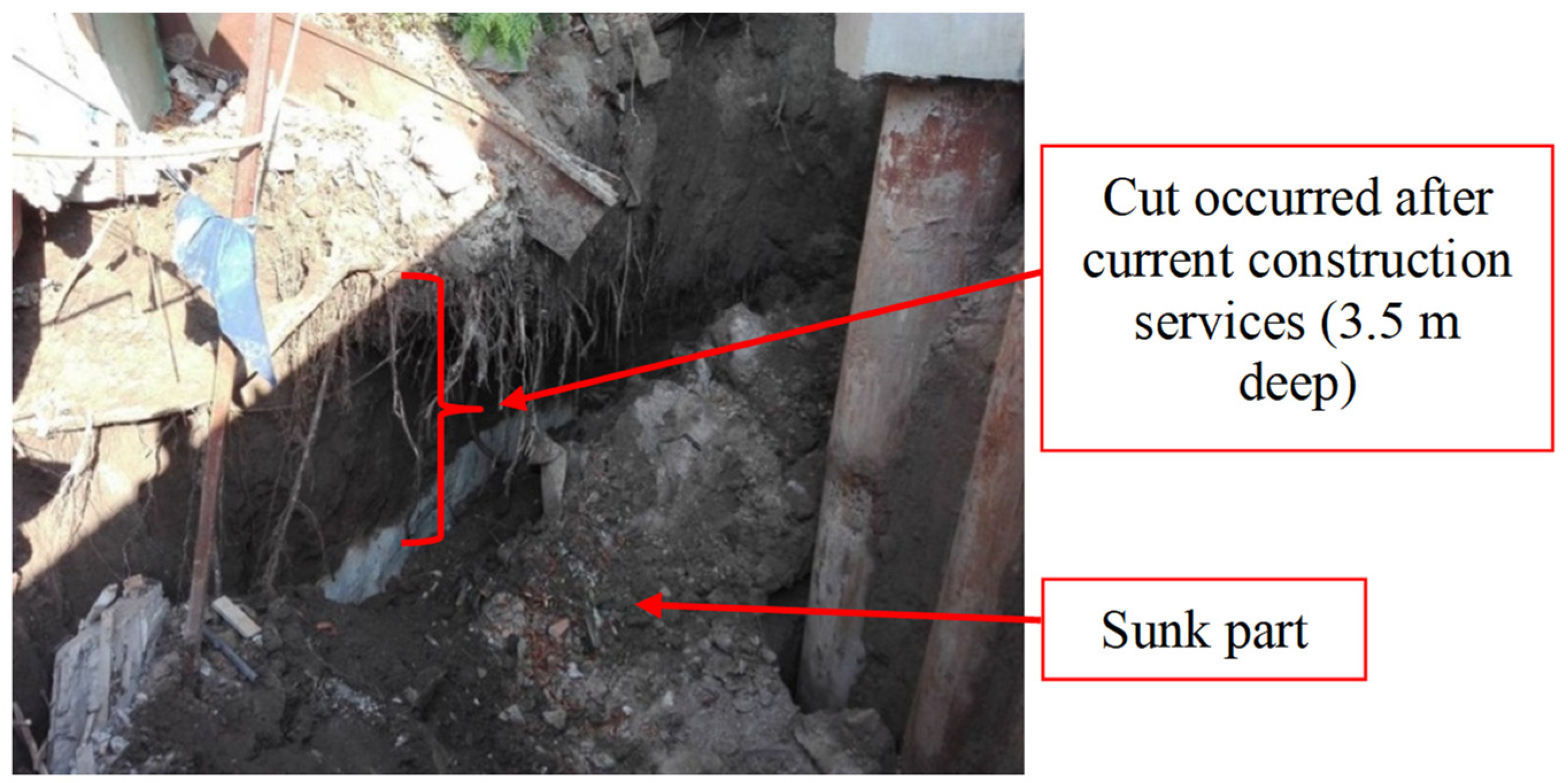


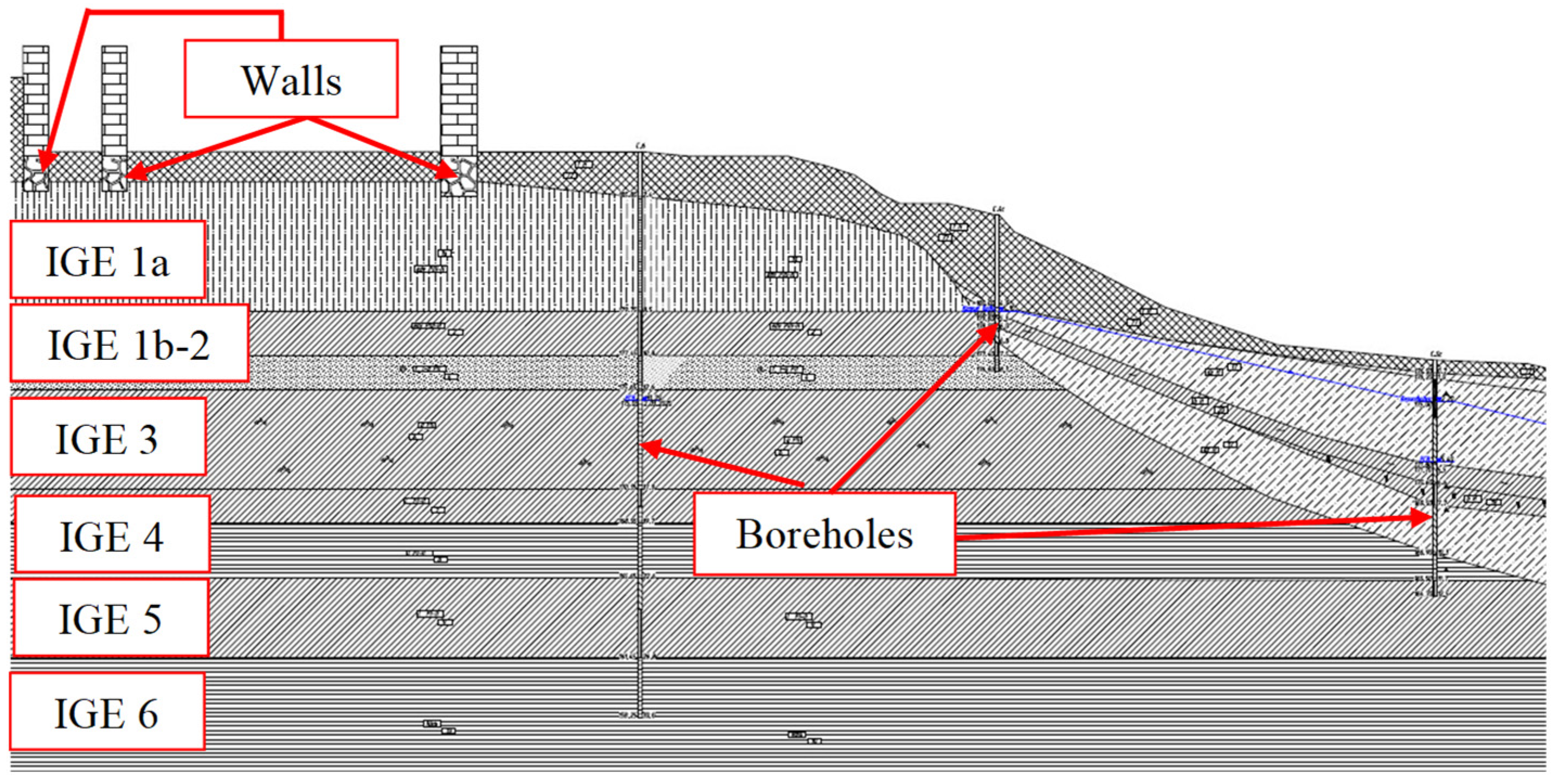

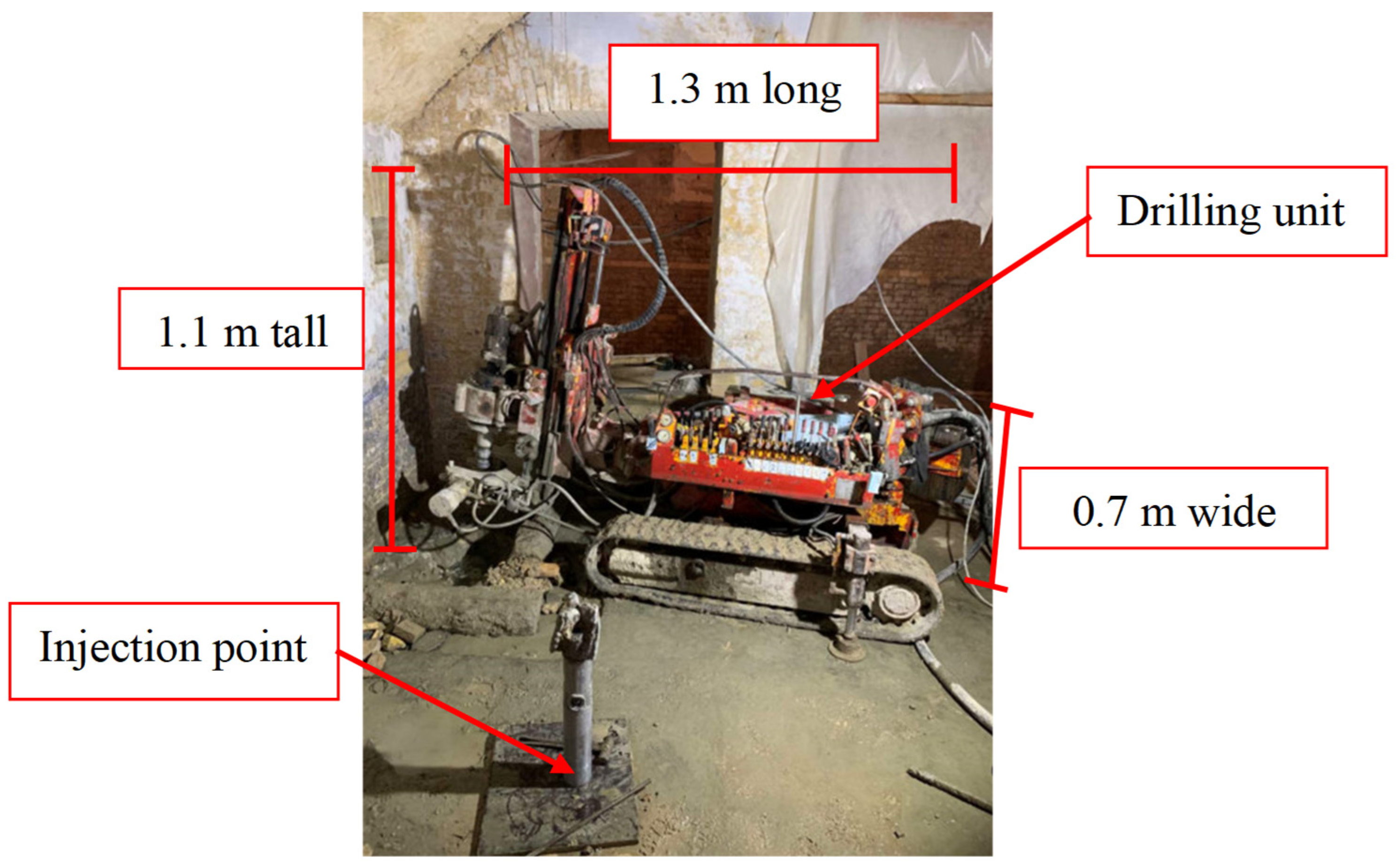
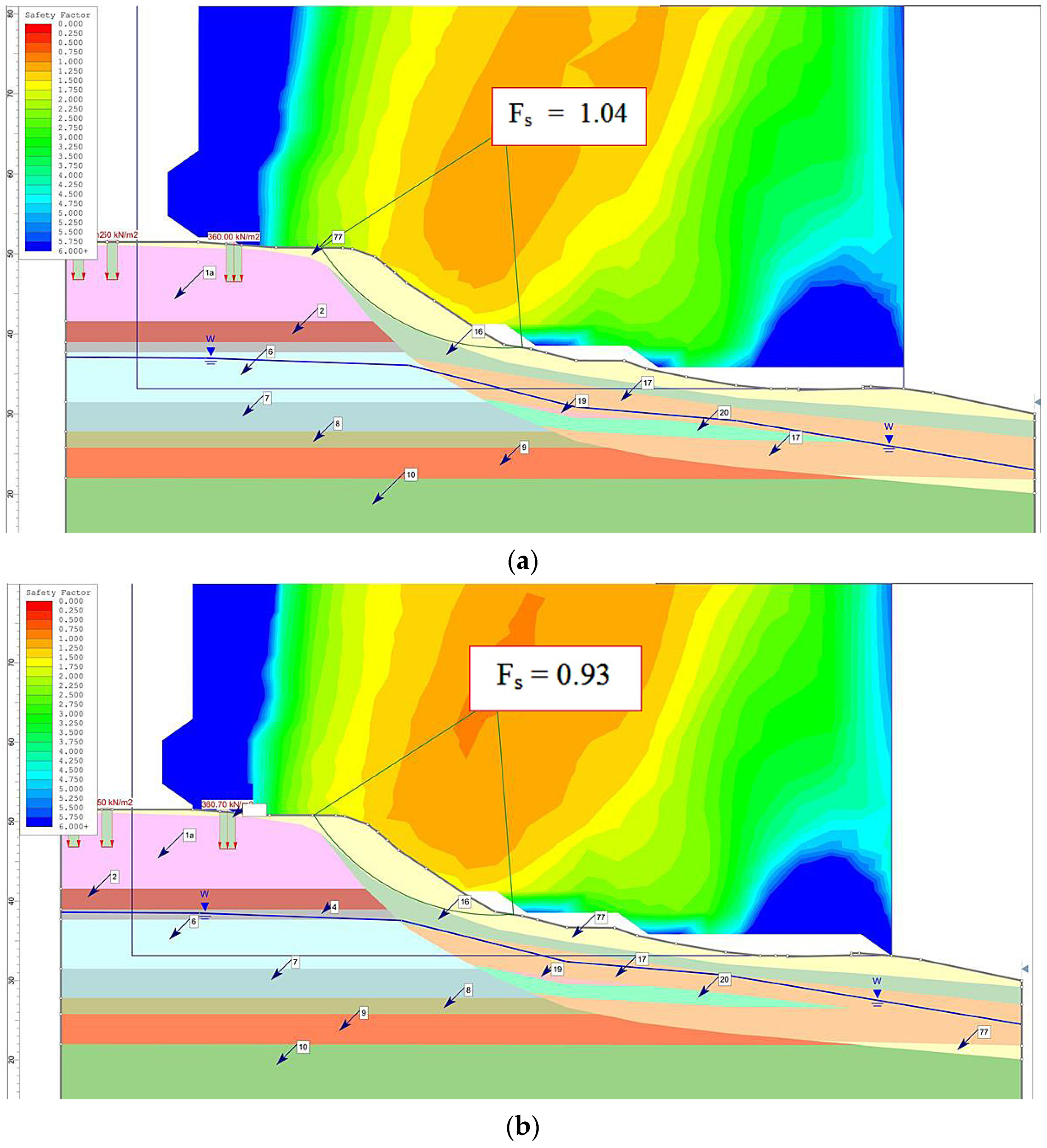
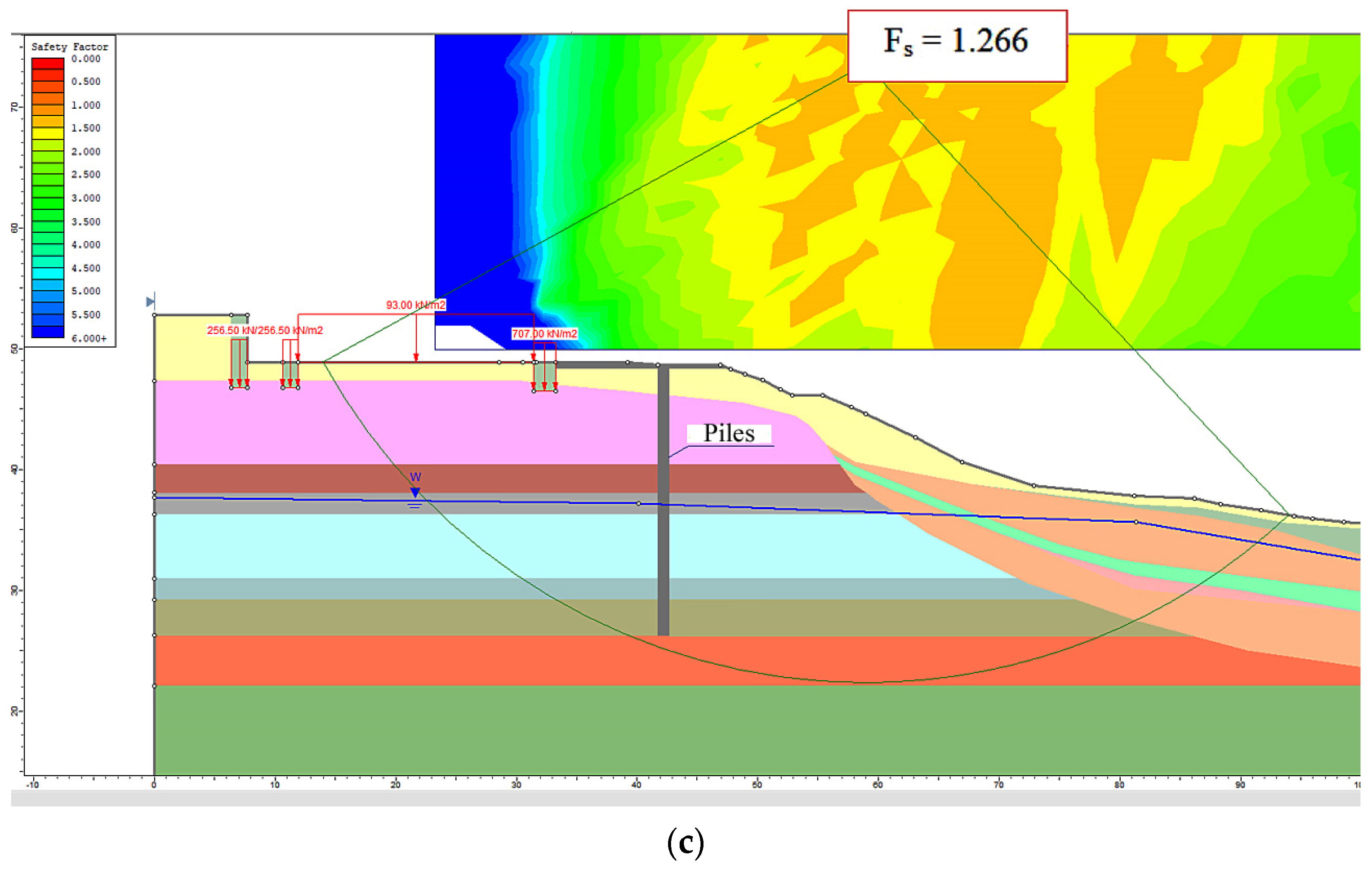

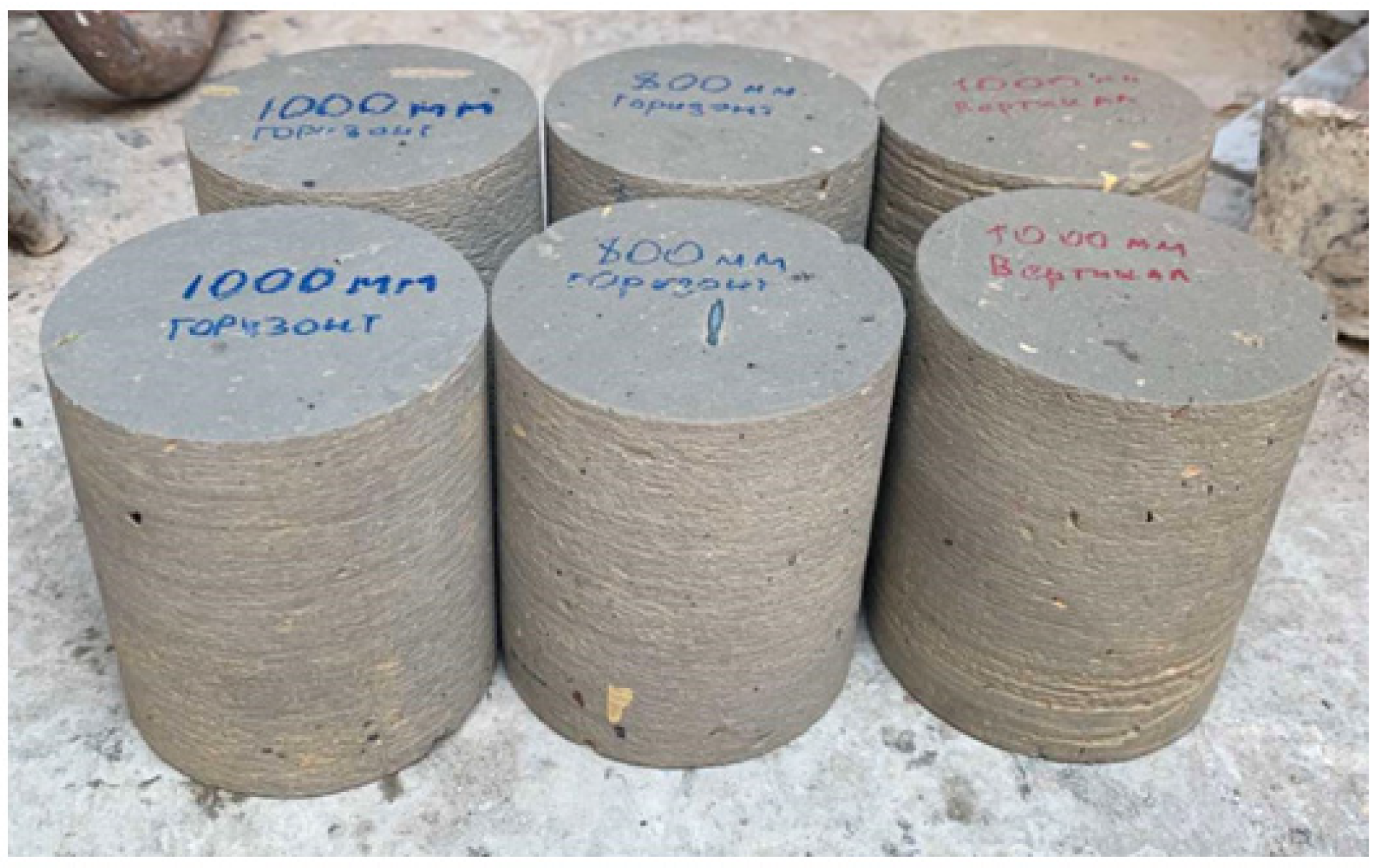
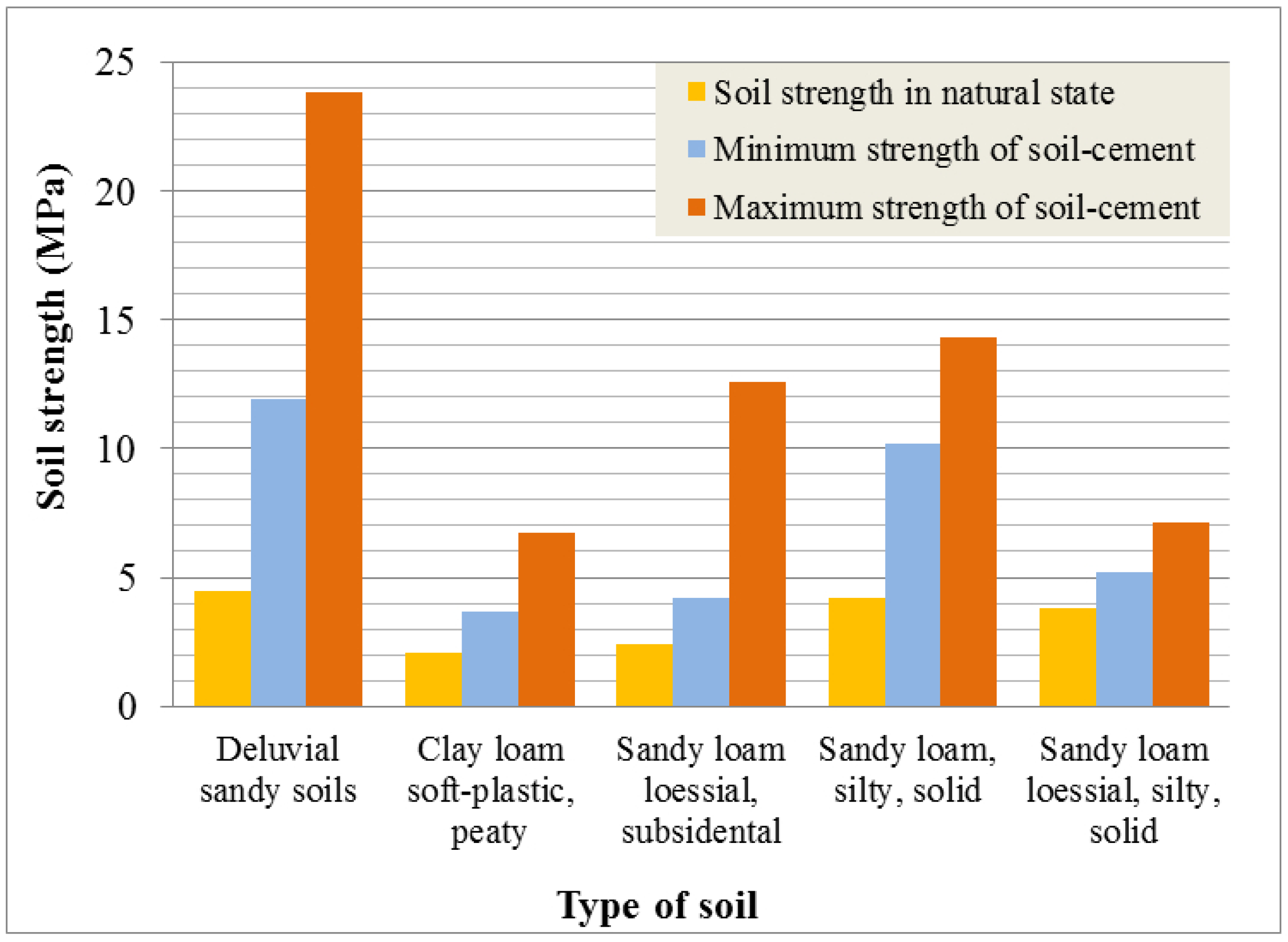
| Method | Equilibrium of Forces | Balance of Moments | |
|---|---|---|---|
| Vertically | Horizontally | ||
| Bishop | Yes | No | Yes |
| Spenser | Yes | Yes | Yes |
| Corps of Engineers No.1 | Yes | Yes | No |
| Lowe and Karafiath | Yes | Yes | No |
| Janbu | Yes | Yes | No |
| Soil Type | Physical and Mechanical Characteristics | ||
|---|---|---|---|
| γ (ton/m3) | c (kPa) | φ (deg) | |
| Deluvial sandy soils | 1.84 | 8 | 18 |
| Clay loam soft-plastic, peaty | 1.69 | 19 | 6 |
| Sandy loam loessial, subsidental | 1.65 | 10 | 22 |
| Sandy loam, silty, solid | 1.60 | 35 | 24 |
| Sandy loam loessial, silty, solid | 1.62 | 36 | 26 |
Publisher’s Note: MDPI stays neutral with regard to jurisdictional claims in published maps and institutional affiliations. |
© 2022 by the authors. Licensee MDPI, Basel, Switzerland. This article is an open access article distributed under the terms and conditions of the Creative Commons Attribution (CC BY) license (https://creativecommons.org/licenses/by/4.0/).
Share and Cite
Severino, A.; Wahrhaftig, A.d.M.; Tiutkin, O.; Gubashova, V.; Neduzha, L. Effective Jet-Grouting Application for Improving the State of Deformation of Landmarks. Buildings 2022, 12, 368. https://doi.org/10.3390/buildings12030368
Severino A, Wahrhaftig AdM, Tiutkin O, Gubashova V, Neduzha L. Effective Jet-Grouting Application for Improving the State of Deformation of Landmarks. Buildings. 2022; 12(3):368. https://doi.org/10.3390/buildings12030368
Chicago/Turabian StyleSeverino, Alessandro, Alexandre de Macêdo Wahrhaftig, Oleksii Tiutkin, Valentyna Gubashova, and Larysa Neduzha. 2022. "Effective Jet-Grouting Application for Improving the State of Deformation of Landmarks" Buildings 12, no. 3: 368. https://doi.org/10.3390/buildings12030368
APA StyleSeverino, A., Wahrhaftig, A. d. M., Tiutkin, O., Gubashova, V., & Neduzha, L. (2022). Effective Jet-Grouting Application for Improving the State of Deformation of Landmarks. Buildings, 12(3), 368. https://doi.org/10.3390/buildings12030368










